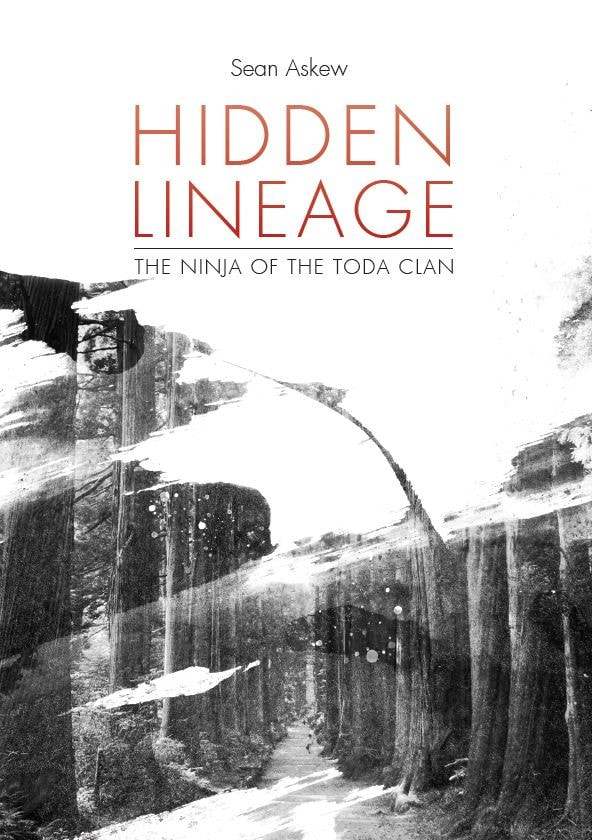 The view of Kobe in the time that Takamatsu was there living on the mountain. This would have been his view of the city.  The stone lantern at the Togakushi shrine near the border of Iga and Nara, it is dedicated to the safety of the soldiers.
0 Comments
The long awaited book by Sean Askew is published and he is taking preorders. Sean Askew dug up a ton of research that has not before been made public. This book covers the history of the Togakure Ryu Ninja, the Toda family's stewardship of the Ryuha (school), and Toda Shinryuken's hidden lineage. This is a must have for all Bujinkan members.
https://bkrbudo.com/book/ Another great essay written by Sean Askew. It is really fun seeing all of the new research being done on Japan's Ninja. The reason for this is because of the 2020 Summer Olympics being in Tokyo. The government knew that all things ninja would be of interest to tourists, so as part of creating ninja attractions for tourists, they are funneling money into researchers digging into old archives to discover information on the ancient ninja that hasn't been brought to light previously. Sean Askew's new book, The Hidden Lineage, due out anytime now, will be an important book for our art and a fascinating read. Enjoy his latest essay below: In a recent research project in Japan executed by the Fukui Prefectural Library, they came up with some interesting finds on the Fukui Domain Shinobi or "ninja". They lived proudly in the castle town, yet their names were mediocre in status. They usually performed normal daily tasks such as Ninjutsu practice, worked as gatekeepers and administered the weapon depots. Their main job was information gathering and they were responsible for writing out and posting the public notices. Based on the castle records written by one of the persons in charge, Fukui Castle researcher, Mr. Eishun Nagano (長野栄俊), has drawn us a picture of the ninja at the end of the Edo period. According to the research done by Mr. Nagano, the ninja of the Fukui domain were called "Shinobimono" (忍之者) etc., and there were 12 Fukui domain ninja in service at the end of the Edo period in the late 1860's. Their status was "bushi" (武士) or warrior. They belonged to the lowermost class of samurai called "Ashigaru" (足軽). Since the status of "Ashigaru" could be purchased by money, Mr. Nagano speculates that "If a ninja had the money they could pay and become an ashigaru samurai of the domain". For Ashigaru, their salary was unusually high, and about 500 tsubo was given to their unit around the present day Hoei 1-chome, Fukui-shi 1-chome and Hinode 5-chome area. They lived in a mansion considered to be a long house (長屋敷). In the center of the map, depicting the castle town at the end of the Bakumatsu period, the word "Shinobi-gumi" is found. Mr. Nagano also reports that "the people of the castle town should have all openly known that it was a ninja's mansion as it is clearly drawn on a public map from the period". The shinobi's names are also recorded in the historical materials. Although, the names are just like names that can be found today, such as "Yamagata Takashi" and "Takahashi Toshisuke". Jokingly, Mr. Nagano says, "It would be easier to search for their offspring if they had distinctive names such as "Kirigakuresaizou" or "Sarutobi Sasuke". "Yoshitsune Ryu" Ninjutsu training According to Mr. Nagano, "Ninja did not do the exciting jobs we think of when we imagine a ninja". It is said that they usually worked as a gatekeepers at the domain's martial arts training halls, and managed the weapons stored in the storehouses of the castle. All while working hard at their Ninjutsu training. Their school of Ninjutsu was the “Yoshitsune-ryū”. Next to their mansion was a handy short-bow (半弓) range It seems the Fukui ninja worked hard at their skills with the bow rather than shuriken. The work that they did do that ties in with the stereotypical image of the ninja is spying. They would gather information from the inside and the outside of the domain. However, what we see in the historical materials from the end of the Edo period, they were often sent to Kyoto to copy the contents of the public notices. According to the scrolls of Yoshitsune Ninjutsu, their main disguises used to prevent raising suspicion were merchants and Yamabushi, but there are no descriptions of ninja hiding in the rafters of an attic in order to steal something or to listen to conversations. At the time of Commodore Perry's "Black Ships" arriving to Japan, the Fukui domain, upon receiving orders from the Shogunate, sent 272 warriors, including three shinobi, to Edo Castle as support. The shinobi's equipment were determined in advance, they wore a black-painted helmets with red armor, armored gauntlets, and a half-bow in their belt at the waist. In addition, they carried a tool unique to the shinobi, the rope and grappling hook, used to climb walls and cliffs. Finally, torches that could be used even in rainy weather. It is also said that they had their very own "servant" called a "Nimotsumochi" (荷物持ち) to carry their weapons and tools. Translated and edited by Sean Askew, 5/1/2019 https://www.fukuishimbun.co.jp/articles/-/317883 Thanks to my good friend Ferreteria Jm for sharing this link with me! Sean Askew If you are searching for a dojo for Martial Arts training (karate, judo, jujutsu, kendo, Taekwondo, Aikido) you will likely be interested in checking out our dojo if a combat martial art with a 1,000 year old heritage is of interest to you.
|
AuthorShane Sensei is a licensed Shidoshi in the Bujinkan and member of the Shidoshi-Kai. He has trained in the Bujinkan since 1998 and regularly travels to Japan for training. Archives
February 2024
Categories |



 RSS Feed
RSS Feed